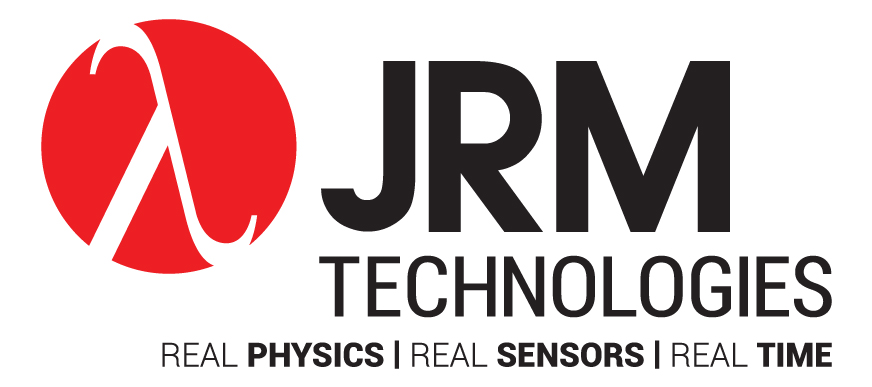GenesisMC
Intelligent, semi-automated material classification application for remote sensed data
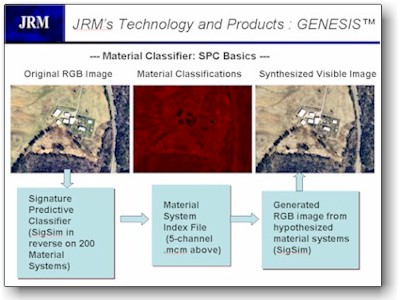 GenesisMC™ (see datasheet) is an easy-to-use, GUI-based semi-automated tool for high-confidence material-classification of arbitrary remote sensed imagery. GenesisMC allows the user to convert the terrain or vehicle imagery into material-system-encoded textures, using smart reverse-signature predictive and spatial algorithms to predict the most likely surface material.
GenesisMC™ (see datasheet) is an easy-to-use, GUI-based semi-automated tool for high-confidence material-classification of arbitrary remote sensed imagery. GenesisMC allows the user to convert the terrain or vehicle imagery into material-system-encoded textures, using smart reverse-signature predictive and spatial algorithms to predict the most likely surface material.
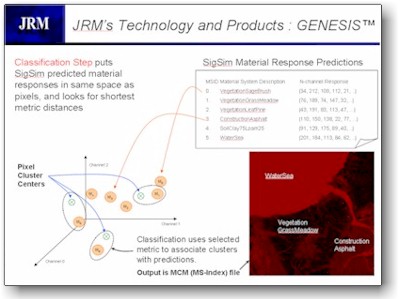 Assigning materials to specific areas of an RGB picture, for example, has been a labor-intensive process. Programs such as ImageMapper have tried to fill the need, but have the inherent problem of using a man-in-the-loop to make decisions, based on visual information. This is tedious work, and no two humans will make the same assignments.
Assigning materials to specific areas of an RGB picture, for example, has been a labor-intensive process. Programs such as ImageMapper have tried to fill the need, but have the inherent problem of using a man-in-the-loop to make decisions, based on visual information. This is tedious work, and no two humans will make the same assignments.
JRM has developed a framework encapsulated in the GenesisMC program effort, which removes the man-in-the-loop and replaces it with computation. The computer is used to find similar pixels and attaches the same material classification to them. This loop is repeated until all pixels are accounted for by a material classification.
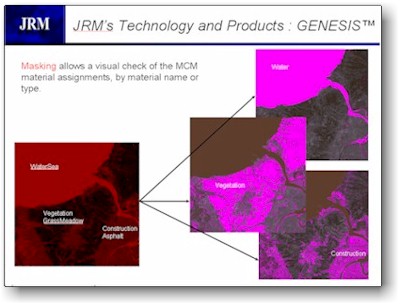 Significant interest in this capability has been generated in the terrain database community, as now there is the opportunity to rapidly create one correlated database capable of supporting different sensor views, effectively decreasing overall system complexity.
Significant interest in this capability has been generated in the terrain database community, as now there is the opportunity to rapidly create one correlated database capable of supporting different sensor views, effectively decreasing overall system complexity.
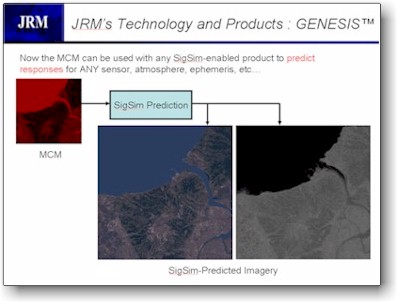 GenesisMC removes the vagaries of the human perception of spectral information by fitting the actual spectral information at hand to spectral signature predictions from a library of material systems. Essentially, instead of asking the question "Given a material, what is its spectral information?" the question is asked, "Given spectral information, what is the material?"
GenesisMC removes the vagaries of the human perception of spectral information by fitting the actual spectral information at hand to spectral signature predictions from a library of material systems. Essentially, instead of asking the question "Given a material, what is its spectral information?" the question is asked, "Given spectral information, what is the material?"
GenesisMC provides high confidence material classifications that may be used by signature prediction software, operating on arbitrary imagery to produce a material-encoded texture for signature synthesis. GenesisMC accepts RGB, multi-spectral or hyper-spectral remote sensed data, and produces a material encoded texture with minimal operator involvement.
Material System Classification of 3D Entity Model Textures
The assignment of materials to textures that define 3D Entity models is equally important to a sensor scene as the material assignment to the terrain. Just as is done for terrain, GenesisMC™ is used offline to assign material systems to 3D Entity model textures, along with associated thermal boundary conditions. A finite difference thermal model, and the choice of BRDF model and its parameters, are assigned/associated with each texel of terrain and 3D Entity models via this material system classification process.
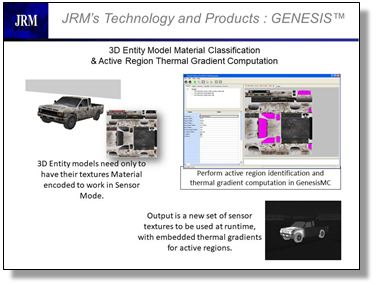 GenesisMC™ also provides an innovative process for modeling the dynamic surface thermal signature gradients of 3D Entity models like vehicles, ships, and aircraft. Users can assign “Active Thermal Systems” to portions of the entity model texture (engine, exhaust, tracks, etc.) These regions are then dynamically controlled, and their temperatures recomputed at run-time in end-user applications. Active Thermal Systems may also be applied to static models such as buildings with heated interiors, or HVAC units on the top of buildings, etc.
GenesisMC™ also provides an innovative process for modeling the dynamic surface thermal signature gradients of 3D Entity models like vehicles, ships, and aircraft. Users can assign “Active Thermal Systems” to portions of the entity model texture (engine, exhaust, tracks, etc.) These regions are then dynamically controlled, and their temperatures recomputed at run-time in end-user applications. Active Thermal Systems may also be applied to static models such as buildings with heated interiors, or HVAC units on the top of buildings, etc.
